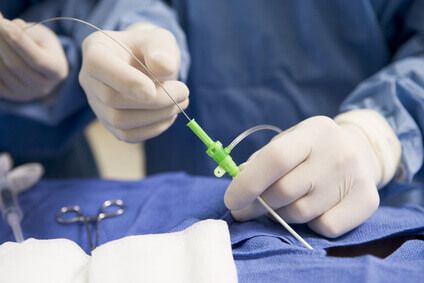The degeneration of transcatheter biological valves clearly depends on time and starts with thrombus generation and subsequent histological changes resulting in valve failure (due to regurgitation, stenosis, or both). Thrombus formation is the first change, observed early in computerized tomography (CT) scans after implantation. Most times it is completely asymptomatic, which leaves many of us…
Bundle Branch Block and Need for Permanent Pacemaker, a Major Challenge after TAVR
Courtesy of Dr. Carlos Fava. The development of new valves for TAVR and the increased experienced of operators have significantly decreased paravalvular leak. However, new bundle Branch block (BBB) and the need for permanent pacemaker (PPM) are still relatively high, and their impact and evolution remain controversial. The study looked at 816 patients, 437…
TAVR Is Feasible and Offers Good Outcomes in Patients with Cancer
Courtesy of Dr. Carlos Fava. Oncology patients have been excluded from all studies, but many of them have a life expectancy of over a year or two, and aortic stenosis can pose a problem as regards their treatment. This study analyzed 2744 patients who underwent TAVR. Among them, 222 presented cancer (8.1%). Patients with cancer were younger,…
Percutaneous Closure Systems Are Safe in TAVR and Aneurysms
Courtesy of Dr. Carlos Fava. Currently, one of our medical challenges is to conduct procedures requiring access with large introducer sheaths in a simpler way, without requiring surgical intervention and closing with percutaneous devices while maintaining procedural quality and safety. There are several devices, but they require a learning curve and the only information available comes…
Is Individual Operator Experience Important in TAVR?
Courtesy of Dr. Carlos Fava. Transcatheter aortic valve replacement (TAVR) has emerged as a successful alternative for inoperable patients and a non-inferior alternative for high- and intermediate-risk patients. While its evolution depending on site experience has been analyzed, there is currently very little information regarding the impact of operator individual experience. This study analyzed 8771 procedures performed…
Acute Coronary Syndromes After TAVR: Frequent and Not All Undergo Coronary Angiography
Approximately 10% of patients who undergo transcatheter aortic valve replacement (TAVR) are readmitted for an acute coronary syndrome after a mean follow-up of 25 months. Male sex, prior coronary artery disease, and (surprisingly and hard to explain) nontransfemoral approach were independent predictors of acute coronary syndrome after TAVR, an event associated with high midterm mortality. While…
Is TAVR at Hospitals Without Backup Cardiovascular Surgery Feasible?
Patients undergoing transcatheter aortic valve replacement (TAVR) at hospitals without cardiovascular surgery available are at significantly higher risk. That in itself is a call for attention; however, a propensity-matched analysis shows that the short- and long-term mortality rates are similar among patients treated at hospitals with and without cardiovascular surgery backup. This debate emerged a…
Aortic Stenosis and Dialysis: Is TAVR the Strategy of Choice?
Courtesy of Dr. Carlos Fava. TAVR has been shown beneficial in high and moderate risk patients, but there is a group of patients that require dialysis on account of kidney deterioration. This comorbidity is due to bad cardiovascular evolution associated to diabetes, bleeding and thromboembolic events. For some time, we have been using an…
CoreValve US Pivotal High Risk Trial: at 5 years, similar results
Courtesy of Dr. Carlos Fava. We are well aware of transcatheter aortic valve replacement’s (TAVR) effect in high-risk or inoperable patients at 5 years, even more after the PARTNER 1 trial. Yet, the outcomes of another relevant randomized study remained pending: el CoreValve US Pivotal High-Risk Trial. The CoreValve US Pivotal High-Risk Trial looked at the…
Surprises in the Physiopathology of Critical Ischemia
Luminal thrombotic occlusions associated with non-significant atherosclerosis are commonly observed in patients with critical lower limb ischemia, which suggests the possibility of thromboembolic disease as a great contributor to ischemia. This was particularly verifiable in infrapopliteal vessels, thus showing a possible mechanism of progression from peripheral vascular disease to critical ischemia, as well as a…









